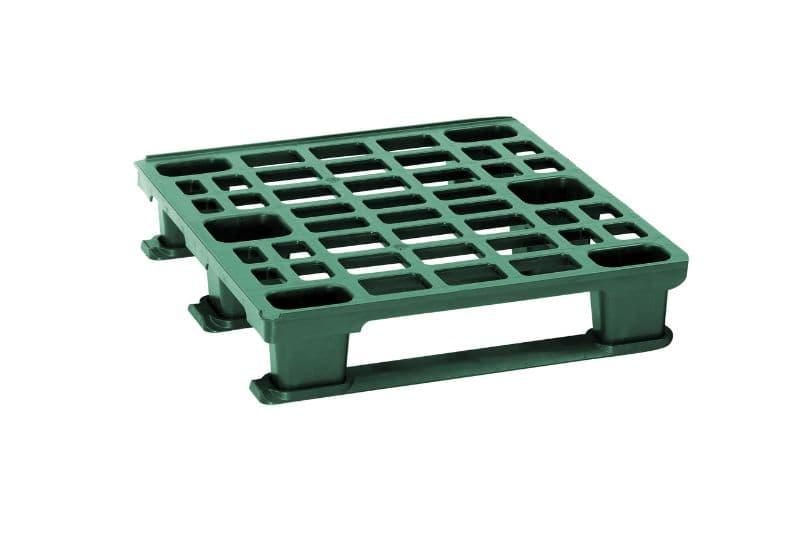Knowing the weight of a pallet is essential for various reasons, such as shipping, inventory management, and determining load capacity.
It’s important to note that pallets vary in weight due to size, material, and overall construction. Wooden pallets tend to be heavier than plastic ones, and the type of wood used also affects the total weight.
In this article, we’ll explore the factors that influence a pallet’s weight and provide some general guidelines to help you estimate the weight of a pallet.
Read: How Much Does a Water Bottle Weigh? (Plastic, Glass & Metal)
Standard wooden pallets usually weigh between 30 and 70 pounds. Plastic pallets are a lighter alternative and weigh between 15 and 30 pounds. Metal pallets, usually made of aluminum or steel can weigh between 65 and 150 pounds. Cardboard pallets are exceptionally lightweight, weighing as little as 10 pounds.
Understanding Pallets
Pallets are an essential tool when it comes to moving goods and materials for various industries.
They provide a sturdy platform that keeps shipments secure and organized, and they play a crucial role in supply chain management.
There are common pallet types that have specific dimensions and weight limits, which we will discuss in more detail.
In addition to the weight of the pallet itself, you’ll also need to consider the weight of the items being stored or transported on it.
The pallet’s combined weight and contents will greatly impact your shipping costs and the required equipment needed for lifting and moving.
Types of Pallets
Pallets are an essential tool when it comes to moving goods and materials for various industries.
They provide a sturdy platform that keeps shipments secure and organized, and they play a crucial role in supply chain management.
Here are the types of pallets and how their weight can impact operations:
Wooden Pallets

Wooden pallets are the most common type of pallets, and they come in various sizes and weights.
Standard wooden pallets usually weigh between 30 and 70 pounds, depending on the type of wood used and the overall quality.
The most commonly used wood types for pallets are pine and oak. Pine pallets are lighter and more affordable, while oak pallets are more durable and can support heavier loads.
Always consider the type of wood when estimating the weight of a wooden pallet.
Plastic Pallets

Plastic pallets are a lighter alternative to wooden pallets, with a weight range between 15 and 30 pounds.
These pallets are made from high-density polyethylene (HDPE) and polypropylene (PP) materials, making them durable and reusable.
Moreover, plastic pallets are resistant to moisture, chemicals, and pests, making them popular in some industries. Remember that different designs and materials affect the total weight of plastic pallets.
Metal Pallets

Metal pallets are significantly heavier than wooden and plastic pallets. They are usually made of aluminum or steel and can weigh between 65 and 150 pounds.
Despite their weight, metal pallets are remarkably strong and can hold up to 4,000 pounds or more. Their durability, strength, and resistance to chemicals make them ideal for use in heavy-duty and high-temperature environments.
Remember that the thickness and type of metal used will impact the pallet’s overall weight.
Cardboard Pallets

Cardboard pallets are exceptionally lightweight, weighing as little as 10 pounds. These pallets are made from corrugated cardboard, making them an eco-friendly and cost-effective alternative to traditional wooden pallets.
While not as sturdy as other materials, cardboard pallets are used to ship lightweight and non-fragile items.
Remember that the type of cardboard, thickness, and construction can impact the total weight of these pallets.
| Type of Pallet | Weight Range |
|---|---|
| Wooden | Between 30 and 70 pounds |
| Plastic | Between 15 and 30 pounds |
| Steel | Between 65 and 150 pounds |
| Cardboard | Around 10 pounds |
Average Weight of Pallets
Standard Pallet Weight
When you need to ship items, it’s essential to know the average weight of a pallet. Typically, the standard pallet used in the United States is the wooden 48″ x 40″ GMA (Grocery Manufacturers Association) pallet.
On average, this type of pallet weighs between 30 and 70 pounds, depending on the type of wood used and other factors.
Some common pallet materials and their approximate weights include:
- Softwood: 30 to 50 pounds
- Hardwood: 55 to 70 pounds
- Plastic: 15 to 30 pounds
- Metal: 65 to 150 pounds
For a more interesting fact about pallets, check out how many pallets you can fit in a 53-foot dry van trailer:
Pallet Weight Limit
It’s essential to know the weight limit of your pallets, as exceeding this limit can affect the safety and efficiency of your shipments.
Generally, most wooden pallets have a weight capacity of around 2,200 to 2,800 pounds.
Plastic pallets, on the other hand, can hold approximately 1,000 to 3,000 pounds, depending on their design.
Please keep in mind these factors when loading your pallets:
- Verify the manufacturer’s recommended weight limit.
- Ensure the load is evenly distributed across the pallet.
- Inspect the pallet for any damage or defects affecting its strength and weight capacity.
By keeping these considerations in mind and understanding the average weight and weight limit of your pallets, you can make informed decisions when planning your shipments.
Factors That Affect Pallet Weight
In this section, we’ll discuss the factors that influence the weight of a pallet. Specifically, we’ll look at the material, size, and load of the pallet.
Material
The material used to make a pallet significantly impacts its weight. As mentioned, pallets can be made of various materials, such as:
- Wood: Wooden pallets are the most common type and can weigh between 30 and 70 pounds, depending on the type of wood used—softwood or hardwood.
- Plastic: These pallets typically weigh between 15 and 30 pounds, making them lighter than wooden pallets. Plastic pallets are often preferred for their durability, ease of cleaning, and resistance to pests.
- Metal: Metal pallets, typically made of steel or aluminum, are the heaviest among the materials. Steel pallets can weigh over 65 pounds, while aluminum ones usually weigh around 30 to 40 pounds.
Remember that these are rough estimates, and the actual weight of a pallet may vary depending on its specific construction and materials.
Size
The size of a pallet is another factor that affects its weight. Pallets come in different dimensions, which can influence their overall weight. For example:
- Standard size: The most common pallet size in North America is 48 inches x 40 inches, which typically weighs around 30 to 50 pounds, depending on the material.
- Euro pallet: Euro pallets are standard in Europe and have dimensions of 31.5 inches x 47.2 inches. They usually weigh between 20 and 45 pounds.
- Custom size: Custom-sized pallets can vary in weight depending on the dimensions and material. Larger or smaller pallets will have different weight ranges.
Load
The load that a pallet is designed to hold can also affect its weight. Different types of goods have different weight requirements, which can influence the weight of the pallet itself.
A pallet designed to support heavy loads, for example, might require stronger, denser materials, while a pallet for lighter loads could be made from lighter materials.
Keep these factors in mind when you’re considering the weight of a pallet, as each component contributes to the overall weight of the pallet itself.
Knowing the factors that affect pallet weight can help you make informed decisions when selecting the right pallet for your needs.
Read: How Much Does a Railroad Tie Weigh? (Standard, Concrete & Steel)
How to Determine Pallet Weight
When trying to determine the weight of a pallet, you can follow these steps to get an estimate:
1. Determine the weight of the empty pallet: Start by weighing the empty pallet on a scale. Note down the weight because you will need it later to calculate the overall weight.
2. Weigh the individual items: Next, weigh all the items that you plan to load onto the pallet. Record each item’s weight separately, depending on the number of items you might want to use a spreadsheet for.
3. Calculate the total weight of items: Add up the weight of all the items you recorded to get the total weight of the items.
4. Add the pallet weight and item weight: Finally, add the total weight of the items to the weight of the empty pallet for an estimate of the pallet’s overall weight.
Remember that these steps assume you have access to weighing scales and the ability to weigh the items and the empty pallet individually.
If you don’t have access to weighing scales, you can still estimate the pallet weight using the abovementioned guidelines.
Conclusion
When considering how much a pallet weighs, you need to consider the weight of the materials used and the weight of the items loaded onto the pallet. You should also remember that different sizes and configurations can affect the weight of a pallet.







